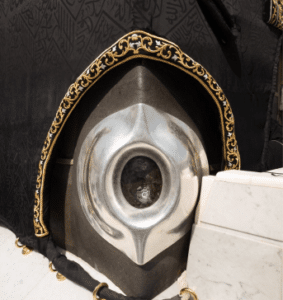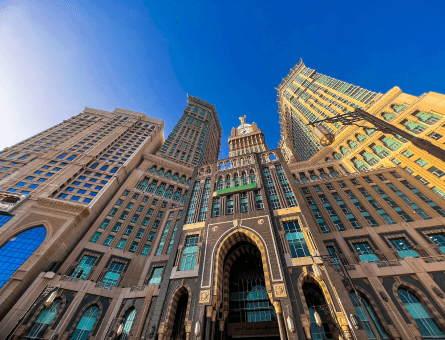Hajr Al-Aswad (The Black Stone From Heaven) – Everything You Need To Know
All religions around the globe have their sacred places and relics that are of the highest value in their religion. Islam also has relics and sacred sites that are of religious significance to Muslims. Installed in the eastern corner of the Holy Kaaba, “The Black Stone” also known as Hajr e Aswad is an Islamic relic that holds significant value for Muslims worldwide. Read on to know more about the history and importance of Hajr e Aswad in Islam.
The Story Behind the Hajr e Aswad
Throughout the history of Islam, a huge number of Muslims go to the Holy city of Makkah in Saudi Arabia to perform Umrah and Hajj every year. While performing Tawaf (circumambulation) around the Holy Ka’bah, it is sacred for Muslims to touch or even see Hajr e Aswad.
According to Islamic history, there are varying tales when it comes to the origin story of the sacred stone. In some places, when Prophet Adam (AS) was sent to earth, Hajr e Aswad fell from heaven to show him where to build the first house of worship.
However, according to the most commonly accepted and authentic narration, it is believed that Hajr e Aswad was brought to Prophet Ibrahim (AS) during the construction of the Holy Kaaba. It is stated that when the construction of the Holy Ka’bah was almost complete, Prophet Ibrahim (AS) noticed an empty space or gap in one of the walls of the House of Allah. Thus, Prophet Ibrahim (AS) asked his son Prophet Ismail (AS) to search for a rock that would fit in the empty space in the wall of the Holy Ka’bah.
Therefore, Prophet Ismail (AS) searched for a stone that would perfectly fit the empty space in the wall of Holy Kaaba. But even after searching the outskirts of Makkah, he was unable to find the perfect stone. On his return to the Holy Ka’bah, he was surprised to see that a magnificent stone was already fitted in the wall’s breech. Upon asking his father, it was revealed that the heavenly stone was sent to Prophet Ibrahim (AS) by the magnificent Angel Jibreel (AS).

In reference to the true colour, sacredness, and heavenly origin of Hajr e Aswad Prophet Muhammad (PBUH) stated:
“When the Black Stone came down from Paradise, it was whiter than milk, but the sins of the sons of Adam made it black.” (Tirmidhi)
The aforementioned hadith is proof that when Hajr e Aswad was brought from heaven it was originally of pure white colour and has turned black due to the sins of mankind.
Another aspect of history is that because of its location in the deep valley of Farhan, the Holy Ka’bah was flooded for most of the year. Heavy rainfall caused significant destruction to the foundation of the Holy Ka’bah. As a result, it was decided to strengthen the foundation of the Holy Ka’bah by reconstructing it. All the Muslims contributed to refortifying and restructuring the foundation of the Holy Ka’bah until it came to placing Hajr e Aswad back.
Each Quraish family was assigned the responsibility of building a quarter of the Holy Ka’bah. Therefore, all the leaders of the Quraish families started quarreling/disputing for the honour of placing the Black Stone. The disagreement and arguments increased to such an extent that there was a high possibility that a war could break out if not controlled in time. Just then, one family member stood up and said, “I have a suggestion; let’s wait till tomorrow and see who enters the Masjid al-Haram first in the morning; then let him decide.” All the other people considered it a sound suggestion and agreed.
The next day, everyone anxiously waited for the first person to enter the Holy Ka’bah. Surprisingly the first person to enter the House of Allah SWT was Prophet Muhammad (PBUH). And because everyone knew, admired, loved, and respected him, they chanted in a loud voice, “Here comes Al-Amin” (the trusted one).
The entire incident was then narrated to Prophet Muhammad (PBUH). While Prophet Muhammad (PBUH) thought of a solution, the people stood in silence. Prophet Muhammad (PBUH) spread his robe on the floor, lifted the Hajr e Aswad and placed it in the middle, and said, “The chief of each family will take one corner of the robe and lift it together.” Upon hearing this, everyone agreed and understood the excellent example of justice. When the robe was lifted to a reasonable height, Prophet Muhammad (PBUH) took the Hajr e Aswad and placed it on its spot with his own hands.
What Is the Hajr e Aswad?
Hajr e Aswad is a sacred stone situated in the eastern corner of the Holy Ka’bah in the city of Makkah, Saudi Arabia. The holy stone is placed in a silver encasement. However, today, the sacred stone’s physical appearance comprises eight small rocks moulded together using the Arabic frankincense. Moreover, while performing Tawaf during Hajj and Umrah, Muslims face the sacred stone. Throughout history, countless Muslims and Prophets (PBUT) have performed Umrah and Hajj around the Holy Ka’bah and have touched their blessed lips to the sacred stone.
During Tawaf, pilgrims strive to touch or kiss the Black Stone as an act of devotion and to seek blessings. Kissing or touching the Black Stone is not obligatory but optional. It is believed to be the act of worshipping Allah SWT and following the Sunnah of Prophet Muhammad (PBUH).
Why Is the Black Stone Important in Islam?
Besides the fact that Hajr e Aswad is a stone from heaven, several sayings of Prophet Muhammad (PBUH) prove the sacredness and sanctity of the holy rock in Islam. The following hadith of Prophet Muhammad (PBUH) proves the significance of kissing the Hajr e Aswad that will bless the Muslims on the Day of Judgement:
“By Allah! On the Day of Qiyaamah, Allah will present the Hajr e Aswad in such a manner that it will have two eyes and a tongue to testify to the Imaan (faith) of all those who kissed it.” (Tirmidhi)
In another hadith, Prophet Muhammad (PBUH) has testified the significance of Hajr e Aswad as the jewel of heaven. The beloved Prophet Muhammad (PBUH) states:
“The Hajr e Aswad and al-Maqam (Ibrahim) are the two jewels from the jewels of Paradise. Had Allah not concealed their radiance, they would illuminate everything between the East and the West.” (Tirmidhi)
Summing it all up, Hajr e Aswad is no ordinary stone. It is believed that the faith of every Muslim who has kissed the sacred stone will be testified by Hajr e Aswad itself on the Day of Judgement. Moreover, touching the Black Stone is also a form of atoning for sins.
Performing Hajj or Umrah, apaart from being an act of worship, overall is also an opportuniy to seek forgiveness for one’s sins and to purify the mind and soul, and touching the Black Stone is another example of the significant weight carried by pilgrimage practises.
Where Did the Hajr e Aswad Come From?
According to Islamic history and the hadith of Prophet Muhammad (PBUH), Hajr e Aswad was brought from heaven to earth by Angel Jibreel (AS). Thus, this proves that Hajr e Aswad is indeed a heavenly stone.
What Is the Hajr e Aswad Made Of?
Originally, Hajr e Aswad was a single stone. However, the stone was broken down into eight pieces due to some incidents. The encasement of Hajr e Aswad that holds the stone together is manufactured from pure silver. It serves as a protective mechanism for the holy stone. The silver encasement was first made by Abdullah bin Zubair (RA) and later replaced by different Caliphs. Hajr e Aswad today measures 7.9 inches (20 cm) by 6.3 inches (16 cm). However, due to the remodeling of the stone on different occasions, the dimensions of the Hajr e Aswad have changed over time.

What Colour Is the Black Stone?
According to Islamic history, it is believed that Hajr e Aswad’s colour was originally pure white (milk white). However, as stated by Prophet Muhammad (PBUH), Hajr e Aswad today is covered by black spots, because of which Muslims also refer to it as the Black Stone.
“When the Black Stone came down from Paradise, it was whiter than milk, but the sins of the sons of Adam made it black.” (Tirmidhi)
Hajr e Aswad Being Mentioned in the Quran
Did you know that Prophet Muhammad (PBUH) named Hajr e Aswad the “right hand of God”? However, there is no direct mention of the holy stone in the Quran (the Holy Book of Muslims).
On multiple occasions, Prophet Muhammad (PBUH) has described the significance of the Black Stone in the lives of Muslims. Prophet Muhammad (PBUH) once said:
“The Hajar al-Aswad and Maqam Ibrahim are two jewels from the jewels of Paradise. Had Allah SWT not concealed their radiance, they would illuminate everything between the East and the West.” (Tirmidhi)
In another place, Prophet Muhammad (PBUH) stated the value of kissing Hajr e Aswad in Islam by saying:
“By Allah! On the Day of Judgement, Allah will present the Hajr e Aswad in such a manner that it will have two eyes and a tongue to testify to the Imam (faith) of all those who kissed it.” (Tirmidhi)
Therefore, the aforementioned hadiths prove that Hajr e Aswad is indeed a special stone, and Muslims should never take it for granted. The Black Stone will be a witness on the Day of Judgement about the faith of Muslims who have kissed it even once in their life.
The Hajr e Aswad Was Stolen
Over time, the sacred stone has suffered significant damage and desecration. During the Umayyad siege of Mecca in 683 CE, the Hajr e Aswad was smashed and struck to pieces by a stone fired from a catapult. The broken pieces of the Black Stone were later rejoined by Abdullah bin Zubair (RA) using pure silver ligament.
Later in the month of January in 930 CE, Hajr e Aswad was stolen by the Qarmatians, who were an Ismaeeli Shia sect. They hid the sacred stone in their base in Hajar (present-day Bahrain). Abu Tahir al-Qarmati, the Qarmatian leader, placed the holy stone in Masjid al-Dirar (Mosque of Abu Tahir al-Qarmati). He did that intending to redirect the Hajj away from the ancient city of Makkah. However, he failed as Muslim pilgrims continued to honour and revere the spot of Hajr e Aswad.
According to Al-Juwayni history, the Hajr e Aswad was returned to the Holy Kaaba in 952 CE after twenty-three years. The Qarmatians actually used the sacred stone for ransom and forced the Abbasids to pay a hefty amount for the return of Hajr e Aswad. As soon as the ransom was paid, the Qarmatians wrapped the Black Stone in a sack and threw it inside the Friday Mosque of Kufa. The sack was accompanied by a letter which stated, “By the command we took it, and by the command, we brought it back.” The Hajr e Aswad was later stored in its original location, where it can be found today.
The process of the removal and abduction of Hajr e Aswad resulted in severe damage to the stone, such that it was broken into eight pieces (fragments). However, according to Qutb al-Din, Abu Tahir al-Qarmati (the abductor) suffered a terrible fate. He said that, “The filthy Abu Tahir was afflicted with a gangrenous sore, his flesh was eaten away by worms, and he died a most terrible death.”

How to and Mannerisms When It Comes to Kissing the Hajr e Aswad
Hajr e Aswad is a gift from heaven, and the reason that Muslims kiss it is that Prophet Muhammad (PBUH) held it in high regard and blessed it with his lips. Therefore, it is essential for Muslims to respect and honour the Hajr e Aswad. However, Muslims should remember that only Allah SWT should be worshiped and nothing else (no stone) in the world. Listed below are some Islamic rules and regulations that a Muslim must keep in mind while kissing the Black Stone:
- While kissing the Hajr e Aswad, Muslims should not push one another and avoid creating hurdles (problems) for other pilgrims while performing Hajj.
- Muslims should also remember that kissing or touching the Hajr e Aswad is a Sunnah, not an obligation.
- Kissing or touching the Hajr e Aswad should only be performed as an act of devotion and love towards the Islamic rituals and not as idolatry.
- According to Islamic history, Prophet Muhammad (PBUH) both kissed and pointed towards Hajr e Aswad while performing Tawaf. Therefore, both actions are accepted as in the sight of Allah SWT, intention is of more significance than the action (deed) itself.
- Millions of Muslims perform Hajj every year. Therefore, if the area around the Hajr e Aswad is crowded, pilgrims should point towards the Black Stone while reciting Takbeer.
Hajr e Aswad – Summary
Hajr e Aswad is a stone from Heaven gifted to Prophet Ibrahim (AS). Being true believers, Muslims must know that the act of touching or kissing the Black Stone is only done because Prophet Muhammad (PBUH) kissed and revered the sacred stone. Hajr e Aswad should be respected and honoured. However, Muslims should keep in mind that Allah SWT alone is the Lord and He alone should be worshiped, and no other thing (or person) reserves that honour.
Explore The New Pilgrim App
The Ultimate App
for Hajj and Umrah!














